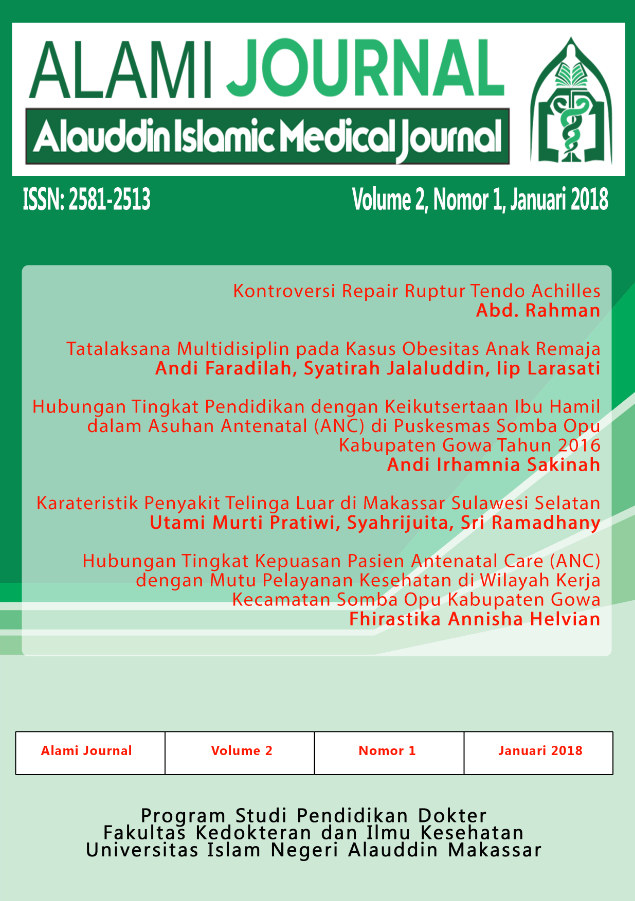Kontroversi Repair Ruptur Tendo Achilles
Abstrak
Tendo Achilles merupakan tendo yang paling tebal dan kuat pada tubuh yang berfungsi sangat penting untuk stabilitas waktu berjalan. Ruptur tendo Achilles sering terjadi pada usia dekade keempat dan paling banyak terjadi secara spontan, baik sewaktu berolahraga, melompat, atau jatuh dari ketinggian. Penanganan ruptur tendo Achilles masih merupakan isu kontroversial. Penanganan operasi memiliki kekuatan otot yang lebih kuat dibanding non operasi sehingga insiden untuk cedera kembali lebih sedikit. Penanganan operasi telah menjadi pilihan pada atlit, orang-orang muda dan pasien ruptur yang lama. Penanganan non operasi dengan immobilisasi gips dilakukan untuk menghindari bahaya dari komplikasi operasi dan anestesi, namun immobilisasi gips yang lama akan menimbulkan atrofi otot betis, kekakuan sendi, memperlama waktu rehabilitasi dan kehilangan waktu kerja yang cukup lama. Tujuan penanganan ruptur tendo Achilles adalah untuk mengembalikan panjang normal dan ketegangan pada tendo dan memungkinkan pasien untuk melakukan apa yang dapat dilakukan sebelum cedera. Penanganan mencerminkan keseimbangan antara perlindungan dan mobilisasi segera. Pilihan penanganan ruptur tendo Achilles menurut beberapa pendapat ahli bergantung pada pendekatan apa yang disukai.Referensi
Moesbar N. Penanganan Cedera Tendon Achilles dengan Mersilene Tape. Majalah Kedokteran Nusantara,Vol 39, No 3, Jakarta, 2006; 202-06
Maffuli N.; Rupture of the Achilles Tendon in The Journal of Bone and Joint Surgery, vol. 81-A, No.7, 1999, p. 1019-31
Young JS, et.al. Achilles Tendon Rupture Generalities. In: The Achilles Tendon, London :Springer; 2007, p. 141-147.
Chairuddin R. Pengantar Ilmu Bedah Ortopedi, edisi kedua. Makassar; Bintang Lamumpatue; 2003, h 463.
Jacobs B, et. al.; Achilles Tendon Rupture in eMedicine Sport Medicine, 2009
Salter RB. Musculoskeletal Injuries. In:Textbook of Disorders and Injuries of the Musculoskeletal System, 3 rd ed., Jakarta; Orthopaedi FKUI, Jakarta; 2008, p. 610-11
Es, at.al. Repair of Acute Achilles Tendon Rupture Using a Double-ended needle. Journal of Orthopaedic Surgery, 2006
Canale, Beaty. Rupture of Muscles and Tendons. In: Campbell’s Operative Orthopaedics, 11 th ed., Mosby, 2007
Skinner HB. Foot and Ankle Surgery. In: Current Diagnosis and Treatment in Orthopedics, 3 rd ed., California; Orange, 2003, p. 517-9
Iversen LD, Clawson DK. Ankle Injuries. In : Manual of Acute Orthopaedic Therapeutics, 3 rd ed.; USA; 198, p. 227
Dandy DJ, Edward DJ. Essensial Orthopaedics and Trauma, ed 4th, Edinburgh, London, New York, Philadelphia, St Louis, Sydney, Toronto; Churchill Livingstone; 2003, P. 266
Sjamsuhidayat R, Jong WD, Penyunting. Buku Ajar Ilmu Bedah, edisi kedua, Jakarta; EGC Penerbit Buku Kedokteran; 2004, hal 1256-7.
Carr AJ, Hamilton W. Orthopaedics in Primary Care, 2nd ed. Edinburgh, London, New York, Oxford, Philadelphia, ST Louis, Sydney, Toronto; Elsevier; 2005, p. 88-9
Demirel M. et al. Augmented repair of acute tendo Achilles ruptures with gastrosoleus turn down flap. Indian J Orthop, 2011
Wheeless CR. Achilles Tendon Rupture. In: Wheeles’s Textbook of Orthopaedics, 2010
Fajar MA. Fractures and Dislocations, 2 nd ed., Dhaka; Sushree; 1990, p 307
Metz R. Acute Achilles Tendon Rupture: Minimally invasive Surgery versus non operative Treatment, with Immediate Full Weight Bearing. Design of a Randomized controlled Trial. In: BMC Musculoskeletal Disorders, 2007
Bannister GC, Webb JM. Percutaneus repair of the ruptured tendo Achilles. The Journal of Bone and Joint Surgery, vol. 81-B, No. 5, September 1999
Lea RB, Smith L, et. Al. Non-Surgical Treatment Tendo Achilles Rupture. The Journal of Bone and Joint Surgery, vol 54-A, No.7, october 1972, p. 1398-1406.
Chapman, Michael W. Tendon Disorders of The Foot and Ankle. In: Chapman’s Orthopaedic Surgery, 3 rd ed., California, Texas; Lippincott Williams and Wilkins; 2001, P 3124.
Once an article was published in the journal, the author(s) are: granted to the journal right licensed under Creative Commons License Attribution that allows others to share the work with an acknowledgement of the work's authorship. permitted to publish their work online in third parties as it can lead wider dissemination of the work. continue to be the copyright owner and allow the journal to publish the article with the CC BY-NC-SA license receiving a DOI (Digital Object Identifier) of the work.

